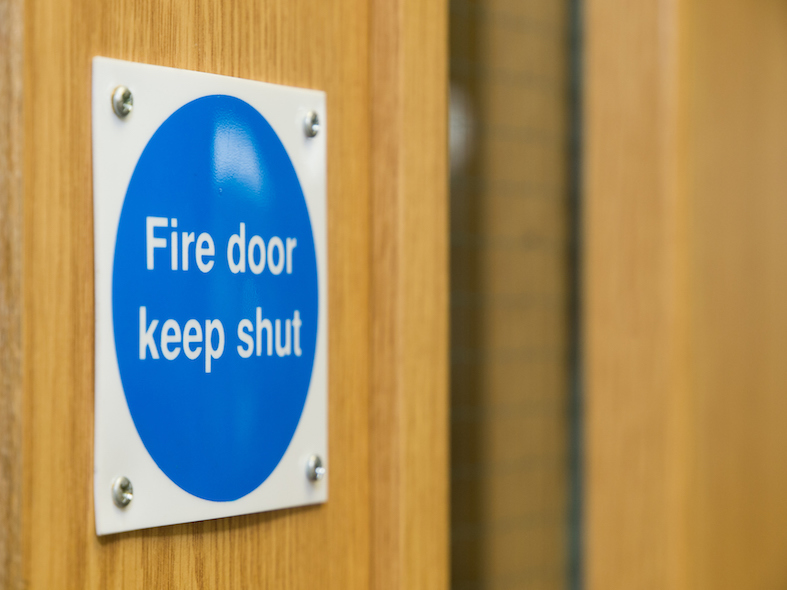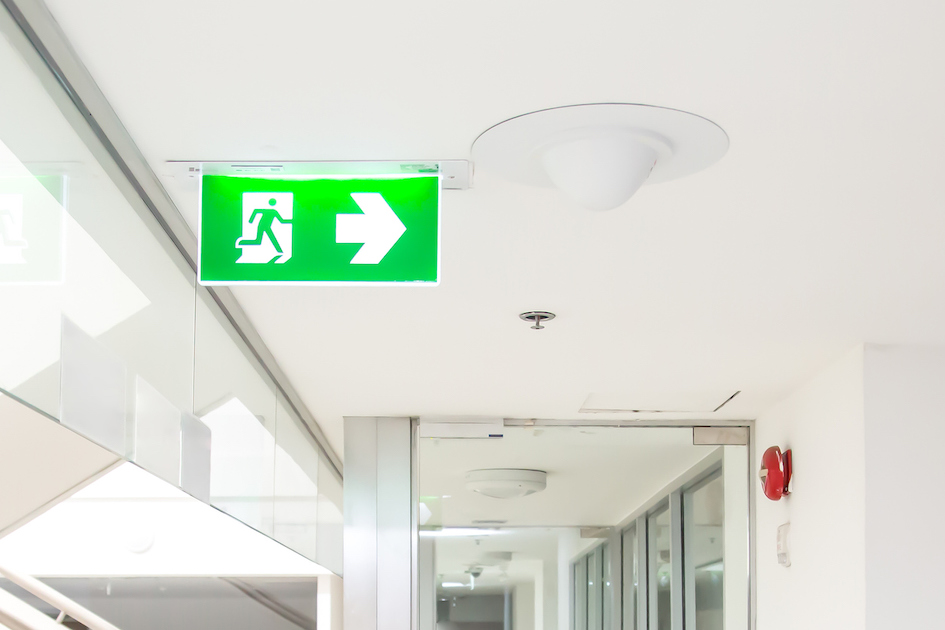Fire Door Regulations – Fire Door Regulations Explained
The Fire Door Inspection Scheme (FDIS) found that more than three quarters of fire doors in UK buildings are not fit for purpose during inspections in 2019. Fire doors prevent the spread of smoke and fire within a building and play a crucial role in the safe evacuation of building users. Thus, adequate fire doors are vital passive fire protection (PFP) measures that must be installed and maintained properly for safety.
Due to the critical importance of fire doors, there are numerous regulations concerning them, their application, and their fire resistance. Failure to meet these regulations can result in repercussions for those responsible, as well as ineffective fire doors, leading to disaster.
In this guide to fire door regulations, we explain key legislation and standards relating to the certification, installations, and materials of fire doors.

Identifying a Fire Door – BS 8214
Fire doors are specially designed and installed doors that prevent the spread of fire and smoke. Unlike regular doors, they have features and components to secure buildings and compartments, including automatic door closure with spring loaded or hydraulic closing mechanism (up to BS EN 1154; the standard for controlled door closing), and fire-resistant seals. They are placed on escape routes, corridors and other rooms within commercial and domestic buildings.
See more: Fire Doors Explained – An Overview of Fire Doors
BS 8214, the ‘code of practice for fire door assemblies’ is a revised standard concerning the installation, maintenance and specification of timber-base fire doors. Notably, this standard states that fire doors should offer a similar level of fire resistance as other fixed elements in a building.
Fire doors are made of metal, timber, gypsum, or a combination of these materials. They may also have glass window panels, made of high fire resistant glass as opposed to regular glass. Hinges, handles, and other ironmongery on fire doors are liable to warp in the high temperatures of fire, and therefore are carefully chosen for the application.
The fitting of fire doors is precise, more so than regular doors, to prevent the spread of smoke through gaps – measured by tests outlined in BS 476-31 (smoke penetration through doors). Fire doors must have a flush fit to the frame, as well as fire-resistant sealant and intumescent stripes that expand in high temperatures of fire to fill gaps.
All of the above components are just elements of what makes a door a fire door. In order to be recognised as a fire door, a door must be certified by a manufacturer and the proof of which be displayed, usually with a label. Without the certification, a door has not been proven to be effective against the effects of fire through various tests of fire resistance, and thusly cannot be claimed to be a fire door.
Fire Door Responsibility – Fire Safety Order 2005
The person in charge of ensuring there is a working fire door (or multiple, as needed) in a building is the ‘Responsible Person’, as outlined by the Fire Safety Order 2005. Employers, landlords, building owners, and facilities managers can be the Responsible Person. It is the onus of this person to keep people safe and ensure the building, and its fire protection elements, are up to standard.
Among the multiple responsibilities of Responsible Persons, fire doors are alluded to; most notably that Responsible Persons must ensure there is safe passage for building users in the event of fire. Escape routes should be as fast as possible, unobstructed, and safe from fire (thanks to effective fire doors).
This responsibility, as outlined in The Order, includes general upkeep and checks to make sure fire doors are in adequate condition and working without issue. In the 2019 report by FDIS, the top three reasons for the condemnation of fire doors were excessive gaps, smoke sealing issues, and poorly adjusted door closers. All of these issues should have been spotted and rectified by Responsible Persons during routine maintenance checks.
Maintenance should include looking for gaps in the frame where smoke could seep through (less than 4mm when closed on sides of door and 8mm on bottom is permissible), assess fixing and condition of hinges to assure effective opening and closing mechanisms, and checking intumescent seals are intact. As there is currently no legal requirement for certification or qualification of installers, maintenance and proactive Responsible Persons can make the difference between ineffective, non-compliant fire doors and safe fire doors.

Fire Door Placement – Building Regulations
Fire doors are required in a range of premises. The use, shape, size and design of a building will affect how many fire doors are needed, where, and to what grade.
The placement of fire doors in commercial properties is dictated by the Fire Safety Order 2005, within Approved Document B: 2006. Guidance on fire doors within non-domestic buildings depends on whether escape routes are horizontal (i.e. corridors) or vertical (i.e. stairs). See Approved Document B for full guidance.
Some domestic dwellings are legally obligated to have fire doors. In homes more than two-storeys high, there must be a fire door separating each habitable room from the stairwell. Fire doors are also mandatory between a two-storey house and internal garage. Other than these instances, fire doors are only legally required internally in House in Multiple Occupation (HMOs).
HMOs are legally required to have doors that are fire resistant with automatic closure for all doors that lead to an escape route. It is advised to have fire doors fitted to rooms at higher risk of fire, such as kitchens, however this optional.
Fire Door Fire Resistance – BS 476-22:1987 & BS EN 1634-1:2014
Each fire doors is given a fire resistance rating, which describes how long the door can withstand fire. This is calculated using tests specified in BS 476-22:1987 and BS EN 1634-1:2014.
The fire resistance grade of fire doors is as follows:
- FD30 (fire resistant for 30 minutes)
- FD60 (fire resistant for 60 minutes)
- FD90 (fire resistant for 90 minutes)
- FD120 (fire resistant for 120 minutes)
- FD240 (fire resistant for 240 minutes)
FD30 is the most commonly specified grade of fire door, followed by FD60. Where 30 minutes of protection is deemed long enough for evacuation, FD30 is specified; any longer and a higher grade is chosen. The highest grades are reserved for specialised applications in high value properties or valuable infrastructure.
Compliant Fire Doors with CPFP
The best way to ensure your fire doors are compliant with regulations and adequate for the job is by enlisting professionals to assess and certify your building. FDIS condemned 30% of inspected fire doors due to poor installations; find certified fire door installers to not make the same mistake!
At CPFP, we are PFP installers, certified with third party accreditation with IFCC to install a range of PFP measures, including fire doors. We install and maintain PFP measures to the highest standard, ensuring the exact following of manufacturers’ guidance, as well as utilising our extensive experience for assured fire protection.
From remedial work on poorly installed, inadequate fire doors, to PFP installations in hotels, schools, offices, HMOs, and more, we help landlords and businesses achieve compliant fire safety measures.
Get in touch for compliant, professionally installed fire doors!
See more: How to Find Out if Your Passive Fire Protection Provider is Certified
Speak to Us Today.
Address: The Old Angel, Flax Bourton, Bristol, BS48 3QQ
Phone: 0117 450 9943
Email: info@cpfp.co.uk
